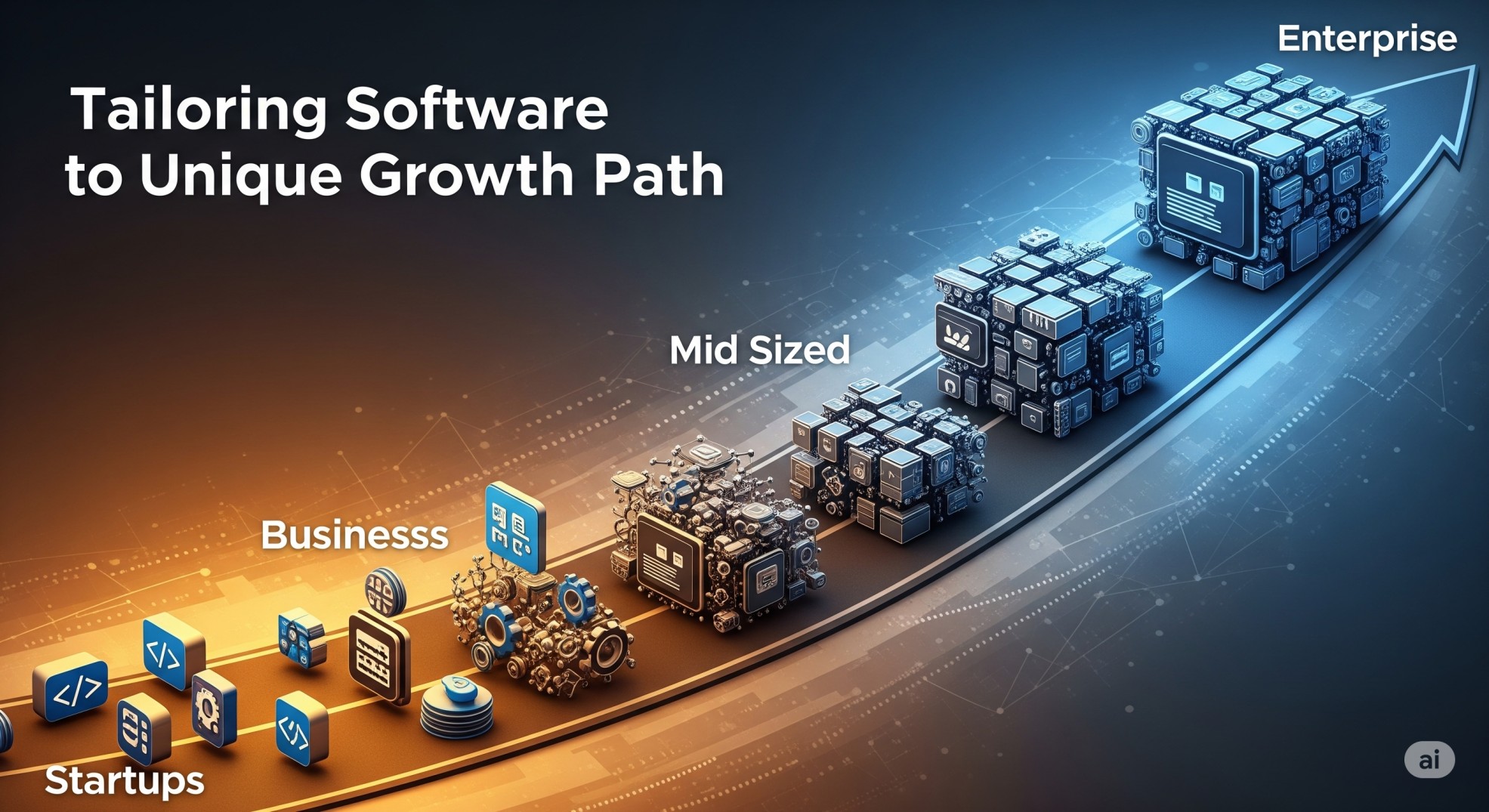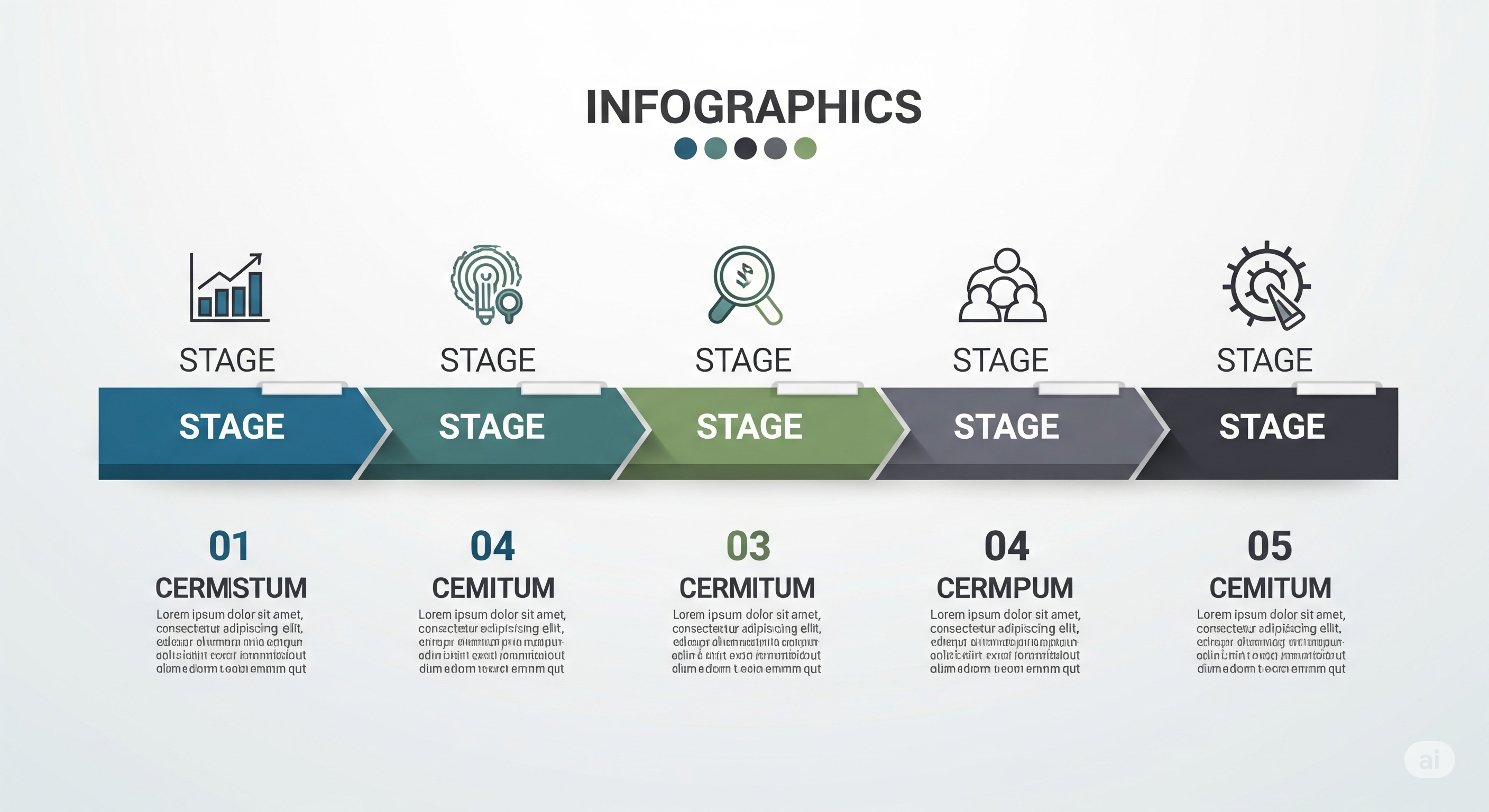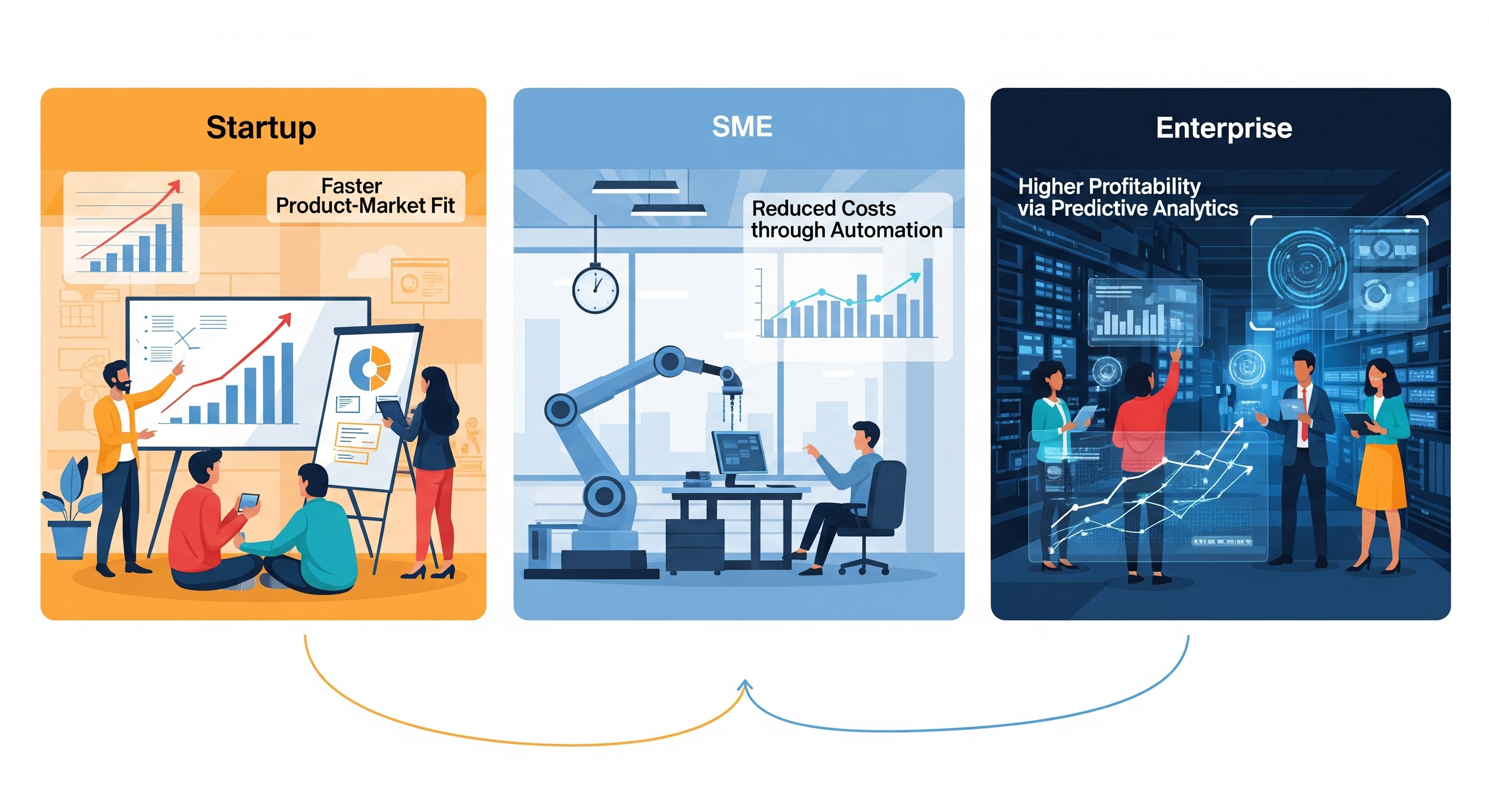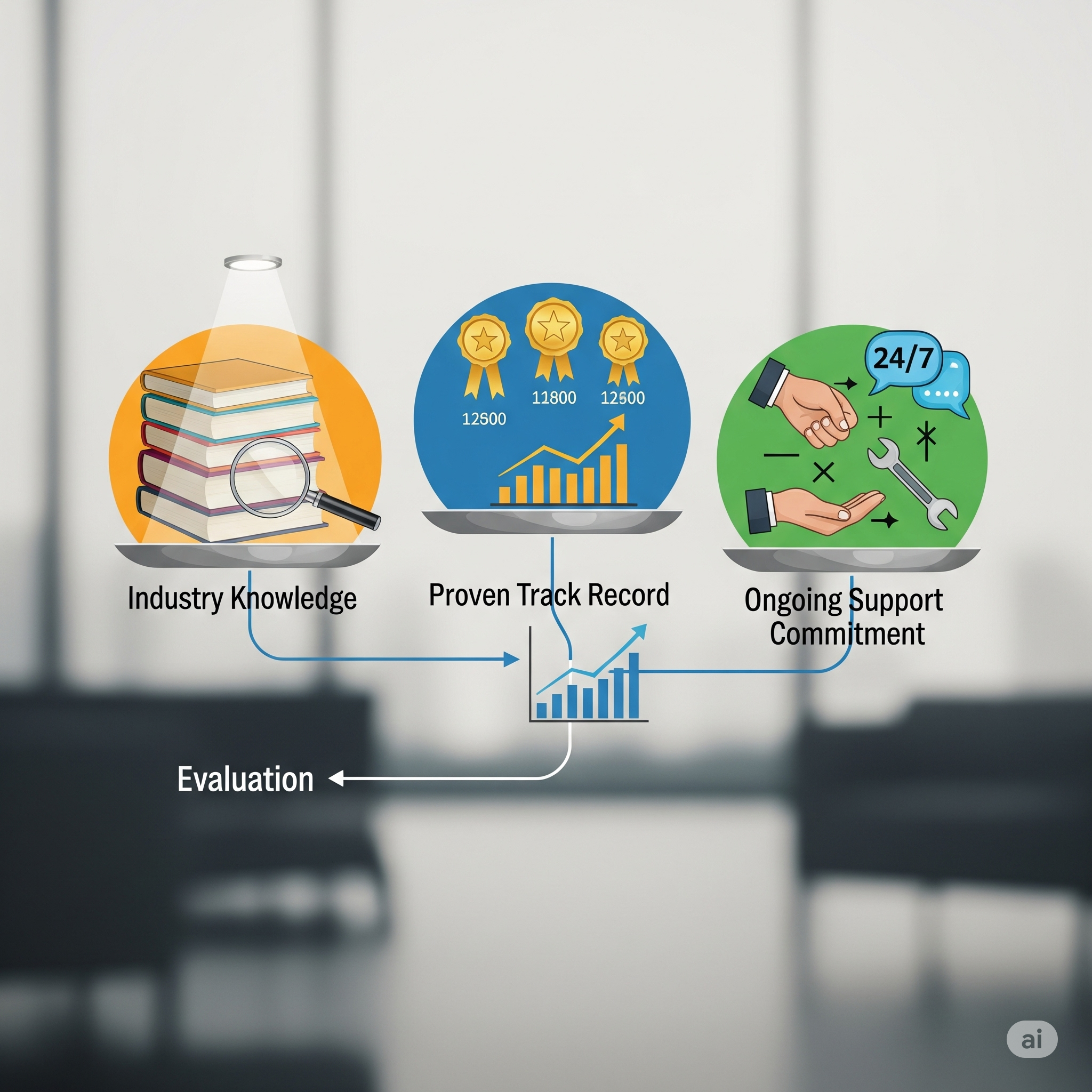From Startups to Enterprises: Tailoring Software to Your Unique Growth Path
In today’s technology-driven economy, software is no longer just a back-office tool — it’s the engine that powers growth, innovation, and customer relationships. But here’s the catch: the software that works for a 3-person startup won’t meet the demands of a 10,000-employee enterprise.
Key Points
- Custom software adapts to your business stage, ensuring efficiency, scalability, and long-term ROI.
- Different business stages require tailored software strategies.
- The right development partner ensures your technology evolves alongside your business growth.
Custom software development solutions are different. They are designed for where you are now, with the flexibility to support where you’re going. Whether you’re trying to launch a minimum viable product (MVP) to impress investors or integrating AI-driven analytics into a multinational workflow, tailored software ensures your technology is a growth enabler, not a bottleneck.
Understanding the Business Growth Path
As businesses evolve, so do their technology requirements. What works for a startup often falls short for an SME, and enterprise-level organizations need far more robust solutions. This is why tailored software development is essential—it adapts to your stage of growth, ensuring efficiency, scalability, and competitive advantage at every step.
1. Startup Stage
- Focus: Speed-to-market, rapid iteration, and proof of concept.
- Challenges: Limited budgets, evolving business models, and the urgent need to attract early customers or investors.
- Software Goal: Build lean but scalable systems that validate the idea quickly while allowing room for future pivots.
Startups thrive on agility. Instead of investing in bloated off-the-shelf tools, custom solutions help them prioritize essential features and release an MVP that can evolve as feedback comes in.
Example: A food delivery startup launched a simple ordering app within weeks. As its user base expanded, the team added secure payments, loyalty rewards, and AI-based recommendations—all without starting over, because the platform was built with modular growth in mind.
2. SME Stage
- Focus: Process automation, customer retention, and operational efficiency.
- Challenges: Balancing growth with quality, managing larger teams, and integrating multiple systems into a single workflow.
- Software Goal: Unify business functions, reduce repetitive tasks, and use data insights for smarter decisions.
At this stage, the priority shifts from rapid experimentation to scaling efficiently. SMEs often struggle with disconnected systems—CRM, ERP, e-commerce, and analytics operating in silos. A tailored solution ensures smoother integration, better visibility, and stronger customer engagement.
Example: A regional retail chain implemented a custom POS system linked to its online store and warehouse inventory. The result was a 20% drop in overstocking, 30% fewer stockouts, and faster checkout times, creating both cost savings and happier customers.
3. Enterprise Stage
- Focus: Large-scale integration, regulatory compliance, and predictive analytics.
- Challenges: Managing global operations, ensuring top-tier security, and adopting AI across complex infrastructures.
- Software Goal: Build robust, secure, and intelligent systems that can operate seamlessly across geographies and business units.
Enterprises deal with massive amounts of data, complex regulatory requirements, and multiple legacy systems. Custom solutions at this level must support global compliance (like GDPR or HIPAA), integrate with both old and new technologies, and harness AI for demand forecasting and business optimization.
Example: A small gym chain initially built a simple membership app. As it grew into a global fitness brand, the system evolved into a full-fledged platform with AI-powered workout tracking, wearable device integration, multilingual support, and advanced loyalty features, allowing it to serve diverse international markets.
A custom software development company can help businesses overcome the limitations of off-the-shelf tools by building solutions that fit their exact needs. Instead of adjusting processes to match generic software, businesses can enjoy applications designed around their workflows, saving time and reducing inefficiencies. For startups, this means launching lean yet scalable products quickly, while enterprises benefit from powerful integrations and automation that support complex operations.
Why One-Size-Fits-All Software Fails
While generic software can be useful for covering basic operational needs, it rarely holds up in industries where competition, scalability, and innovation define success. What starts as a convenient, low-cost solution often becomes a bottleneck as the business grows.
- Lack of Flexibility – Off-the-shelf systems require businesses to adjust their workflows around the software’s limitations. Instead of supporting unique processes, they restrict innovation and force teams to compromise efficiency.
- Limited Scalability – As companies expand, these tools often struggle with higher transaction volumes, larger databases, or added users. This leads to performance slowdowns and, eventually, expensive migrations.
- Integration Friction – Most pre-packaged platforms aren’t designed to integrate seamlessly with other business-critical tools. This creates data silos, manual workarounds, and fragmented workflows.
- Security Risks – Widely used systems are often the first target for cybercriminals. With standardized code and vulnerabilities well-known across industries, these solutions can expose businesses to greater risks.
Example: A startup may initially rely on a popular cloud invoicing tool. It works fine in the first year, but by year three—after expanding into international markets—they suddenly require multi-currency support, automated tax compliance, and API integration with logistics systems. At that point, the software becomes a dead end, forcing them to either compromise on functionality or invest heavily in a full migration.
Tailored Software for Startups
For startups, every decision counts—time, budget, and agility often determine whether an idea thrives or fades. That’s why custom software designed for early-stage businesses focuses on speed, cost-efficiency, and adaptability.
Priorities for Startups
- Fast Launch – Quickly build and release an MVP to test the market.
- Budget-Friendly – Keep development lean while leaving room for scalability.
- Flexibility – Pivot features and workflows as customer feedback evolves.
Features That Matter
- Payment Gateway Integration – Enable seamless transactions from day one.
- User-Friendly Design – Simplify onboarding and improve customer adoption.
- Modular Architecture – Add or swap features without major rework.
- Cloud-Based Deployment – Scale usage as demand grows without heavy infrastructure costs.
Example: A health-tech startup launched a telemedicine platform in just 12 weeks, starting with core video consultation features. Within six months, they expanded to include AI-powered symptom checking and e-prescriptions—all without rebuilding the system, thanks to its modular, cloud-native design.
Partnering with experts in custom software development solutions also gives companies access to modern technologies like AI, cloud computing, and API-driven architecture. This ensures their software isn’t just functional today but adaptable to future growth. For instance, a small e-commerce store can begin with a tailored inventory system and later expand it into a full-scale ERP as its customer base grows. This flexibility is what sets tailored development apart from one-size-fits-all products.
Scaling Up: Custom Software for SMEs
Small and mid-sized enterprises (SMEs) often reach a stage where spreadsheets and basic tools no longer cut it. To stay competitive, they must focus on automation, integration, and customer engagement—all areas where custom software becomes a game-changer.
Priorities for Growing SMEs
- Automating Repetitive Tasks – Freeing up teams from manual processes so they can focus on growth-driven activities.
- Integrating Systems – Connecting accounting, sales, inventory, and customer data for smoother operations.
- Improving Customer Engagement – Delivering faster responses, personalized offers, and seamless service experiences.
Features That Matter
- ERP & CRM Integration – Unify data across departments for better decision-making.
- Custom Analytics Dashboards – Gain real-time insights into performance and trends.
- Omnichannel Customer Support – Provide consistent experiences across chat, email, phone, and social media.
- Marketing Automation – Streamline campaigns and nurture leads more effectively.
Example: A regional retail chain built a custom POS system linked directly to its e-commerce store and warehouse inventory. This upgrade led to a 20% reduction in overstocking, 30% fewer stockouts, and a noticeably faster checkout experience that improved customer satisfaction.
Enterprise-Level Custom Software Solutions
Large organizations face challenges that go far beyond everyday operations. Managing global complexity, meeting strict regulatory compliance standards like GDPR or HIPAA, and leveraging AI-driven insights for smarter decision-making require more than generic software. This is where enterprise-level custom solutions prove indispensable.
Priorities at the Enterprise Scale
- Managing Global Complexity – Coordinating operations across regions with different languages, currencies, and regulations.
- Ensuring Compliance – Staying compliant with data privacy, industry-specific rules, and international standards.
- AI for Smarter Decisions – Using advanced analytics and machine learning to forecast demand, improve resource allocation, and reduce risks.
Features That Matter
- Secure, Role-Based Access Controls – Protect sensitive data while enabling collaboration across large teams.
- Cross-Border Compliance Automation – Automate tax, customs, and legal requirements across jurisdictions.
- AI-Powered Demand Forecasting – Use predictive analytics to optimize supply chains and reduce waste.
- Seamless Integration – Connect legacy systems with modern applications to ensure smooth operations.
Example: A multinational logistics company built a custom supply chain management platform integrating IoT shipment tracking, predictive analytics, and automated customs documentation. The result? Delivery delays dropped by 25%, boosting both efficiency and customer satisfaction.
Step-by-Step Process to Tailor Software to Your Growth Path
Creating custom software that grows with your business requires a structured approach. By following a well-defined process, you ensure the solution addresses current needs while remaining flexible for future expansion.
1. Needs Assessment – Define Challenges and Opportunities
The process starts with identifying your current pain points, inefficiencies, and long-term growth objectives. This phase often includes stakeholder interviews, process mapping, and competitor benchmarking to ensure your software aligns with your strategic goals.
Example: A retail business struggling with inventory shortages identified real-time stock tracking as a critical feature during the needs assessment stage.
2. Prototyping – Validate the Vision Early
Before committing to full-scale development, creating a visual mockup or functional Minimum Viable Product (MVP) allows you to test core concepts with real users. This feedback helps refine the product direction and avoid costly rework.
Example: An SME developed a customer portal prototype in just two weeks, tested it with 50 loyal customers, and used their feedback to enhance the interface before full development.
3. Custom Development & Integration – Build for Your Ecosystem
This is where the core features are coded and integrated with your existing systems, such as CRMs, ERPs, or marketing automation tools. The focus is on building scalable, secure, and performance-oriented software tailored to your exact requirements.
Example: A logistics company integrated custom route optimization software with their existing fleet management system, reducing fuel costs by 15%.
4. Testing & Optimization – Ensure Quality and Reliability
Rigorous testing, including functional, usability, and security checks, ensures the software performs flawlessly under real-world conditions. Optimization at this stage improves speed, reduces bugs, and enhances user satisfaction.
5. Ongoing Support – Adapt to Evolving Needs
Post-launch, your software should evolve alongside your business. Continuous updates, feature enhancements, and performance monitoring help maintain relevance and efficiency.
Example: The same SME that built the customer portal later added advanced loyalty features within three months, increasing customer retention rates by 25%.
ROI of Custom Software at Different Business Stages
Custom software development isn’t a one-size-fits-all investment—it delivers different, yet equally powerful, returns depending on your company’s growth stage. From early-stage agility to enterprise-level data intelligence, the ROI can be transformative.
1. Startups – Faster Product-Market Fit
In the early days, speed and adaptability are everything. Off-the-shelf solutions often come bloated with unnecessary features or lack the flexibility to adapt quickly. Custom software enables startups to focus only on essential features, launch faster, and iterate based on real customer feedback. This shortens the time to product–market fit, making the startup more attractive to investors.
Example: A SaaS startup built a custom analytics tool to track user behavior in real-time. Within weeks, they identified underused features, refined their product, and secured a $500k funding round thanks to the improved user retention metrics.
2. SMEs – Cost Reduction Through Process Automation
For small and mid-sized enterprises, scaling without spiraling costs is a constant challenge. Custom software can automate repetitive tasks—such as inventory tracking, invoicing, or customer support—resulting in 20–40% cost savings and allowing teams to focus on higher-value activities.
Example: A mid-sized service provider integrated an AI-powered chatbot into a custom CRM, reducing customer service costs by 40% while cutting average response time from 3 hours to under 1 minute.
3. Enterprises – Predictive Analytics for Higher Profitability
At the enterprise level, the competitive advantage often comes from turning data into actionable insights. Custom solutions can integrate predictive analytics, enabling smarter forecasting, risk reduction, and performance optimization—ultimately improving profit margins.
Example: A global retailer implemented a predictive demand planning tool that reduced overstock and stock-outs by 30%, saving millions annually and improving customer satisfaction.
How to Choose the Right Development Partner
Choosing the right custom software development partner can mean the difference between a high-performing asset and a costly misstep. Beyond technical skills, the right partner brings industry insights, proven experience, and a commitment to long-term success.
1. Industry Knowledge
A deep understanding of your sector ensures your partner can anticipate challenges and design solutions that align with industry-specific workflows and compliance regulations. This is especially critical in fields like healthcare, finance, and manufacturing.
Example: A healthcare startup working on telemedicine software should work with a partner familiar with HIPAA compliance to avoid costly legal setbacks.
2. Proven Track Record
Look for case studies, references, and project portfolios that show successful delivery in projects of similar scale and complexity. Consistent delivery is a strong indicator of reliability and quality.
Example: If you’re in logistics, a partner with experience building fleet tracking or route optimization software will likely deliver a faster, more tailored solution.
3. Ongoing Support Commitment
Custom software is never truly “finished.” Market demands shift, technologies evolve, and your business needs will change. Choose a partner who offers continuous maintenance, feature updates, and scalability support as part of their service model.
Example: A fintech firm requiring PCI DSS compliance should work with a development partner offering ongoing compliance updates to meet changing security standards, not just initial certification.
Most importantly, a trusted software development partner offers more than coding—they provide strategy, consultation, and ongoing support. They work closely with you to understand your goals, whether it’s improving customer experience, streamlining internal processes, or reducing costs. With the right custom solution, businesses at every stage—startup, SME, or enterprise—can accelerate digital transformation and gain a competitive edge in their industry.
Conclusion:
From the agility of startups to the sophistication of enterprises, custom software development provides the flexibility, scalability, and precision modern businesses demand. Unlike generic solutions, tailored software grows alongside your organization—adapting to new markets, integrating emerging technologies, and supporting evolving customer needs. With the right development partner, your software becomes more than a tool; it transforms into a long-term growth engine that ensures you remain competitive in a fast-changing digital landscape.
FAQs
Q1: What is a custom software development solution?
A tailor-made application built to meet your specific business needs, offering greater flexibility than off-the-shelf software.
Q2: How do software needs differ for startups, SMEs, and enterprises?
Startups need speed and agility, SMEs require automation, and enterprises focus on security and integration.
Q3: Is custom software better than off-the-shelf software?
Yes, because it scales with growth, integrates with your systems, and matches your processes exactly.
Q4: How long does it take to develop custom software?
From weeks for an MVP to several months for enterprise-level solutions, depending on complexity.
Q5: How much does custom software cost?
Costs vary from a few thousand dollars to millions, depending on features and scale.
Q6: Can custom software integrate with existing tools?
Yes, especially when designed with API-first architecture.
Q7: What technologies power modern custom software?
Cloud computing, AI, low-code platforms, and API-driven integrations.
Q8: How do I choose the right software development partner?
Look for industry expertise, a strong portfolio, and robust post-launch support.




